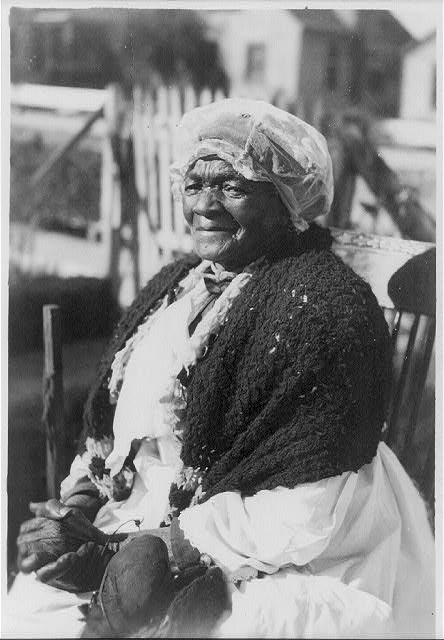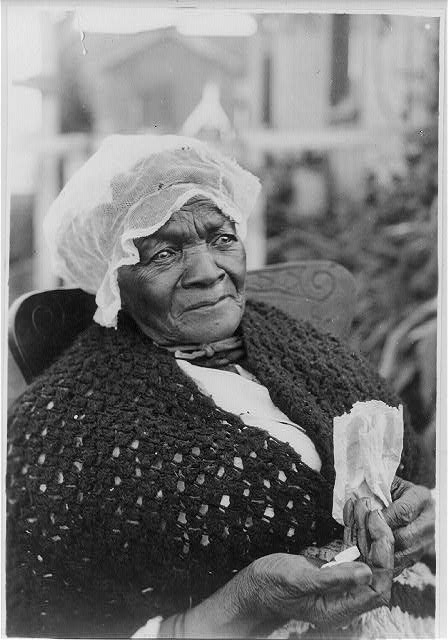In 1920, Paul F. Collins, a census worker in Los Angeles, approached a small farmhouse on Pennsylvania Avenue in Los Angeles. He was greeted by an elderly lady who gave her name as Anna or Annie Prater. (Note: in all subsequent articles and via the Library of Congress, she’s called Mammy, which she evidently preferred, so I’ll use that name in this post.)
Collins commenced to gather her information. Whatever his expectations, if he had any were, they likely did not include meeting a personage like Mammy, who coolly informed him she was born in 1805 in Darlington, South Carolina. Collins did the math: if she had given the correct date, the woman before him was 115 years old, which made her the oldest person living, at least west of Chicago. To give you an idea of the sheer volume of time and history that she lived through, Mammy had by then lived through six monarchies and 27 presidencies.
Besides her remarkable age, Collins could be forgiven for doubting his ears. At 115 years old, you might imagine a frail elderly lady, but Mammy was not that. A few photographs of her exist and are available in the Library of Congress. The description of one of them reads: “Mammy Prater, a 115-year-old ex-slave who is still hale and hearty.”

Mammy Prater, Library of Congress
Mammy told him she’d been born a slave in South Carolina, but had left the area in 1838. (Unfortunately, I could find very little information about her life and the circumstances for her leaving South Carolina, or where she had spent the next 80 years of her life.)
Collins dutifully captured her information in the census but didn’t know whether to believe the date she gave. Public records in 1920 were not known for their precision under the best of circumstances. And even if it was possible for him to retrieve documentation from a town over 2,500 miles away, there was no hope that any records existed for a woman born into slavery over a hundred years earlier.

Mammy Prater, Library of Congress
Mammy Prater’s story, however, was destined to be verified, in the most unlikely way imaginable. In February 1920, the Los Angeles Times covered the story. A 68-year-old South Carolina planter named J.B. Law was visiting his nephew in Burbank, California. Somehow, during his visit, he learned of Mammy’s existence and deduced she had been slave on his family’s plantation. His visit to California was nearing its end, but he wanted to see her. He asked if he could visit and she allowed him to come. They had never met, as J.B. was born in South Carolina in 1852, fourteen years after Mammy had left the area.
But there was no doubt of her identity. Mammy recollected his father Ezekiel, who was four years younger than her, when he was a little boy. She also remembered his grandfather William, who died in 1812. Throughout the afternoon, she told J.B. about events that he had heard of, that had been passed down through family lore for many years.
The last contemporary article I found about Mammy Prater was written in August 1922, in the Cherokee Times, a Gaffney, South Carolina newspaper. The article gave her age as 118. Mammy was still living on the Los Angeles farm; she was still able to see and hear quite well, and enjoyed sewing. In response to the paper’s questions, she attributed her long life to hard work and plain food. She weighed 150 pounds and said though she didn’t care for much meat, if she had her way, her diet would be chicken.

Mammy Prater, Library of Congress
Though there wasn’t much more information about Mammy’s life, I did find the 1920 census that occasioned her talk with Paul Collins, and it told us a little more. Mammy listed her marital status as widowed, and said she was the head of her household. The most interesting thing on the form is that Mammy indicated she could read and write.
In the nineteenth century, the very poor were less likely to be literate. School was a luxury many people just couldn’t afford for their children. Slaves had the very least opportunity; in many places, it was illegal for them to learn to read and write. And yet, Mammy Prater, born into slavery, somehow learned anyway.

Mammy Prater writing
Electronic image available at faculty.arts.ubc.ca/kmcneill/222_2015.htm
Philosophers talk about the human spirit triumphing over adversities, but always in a spectacular way. The stories of unknown people like Mammy who overcame so much to live a humble, happy life are so much more interesting than the celebrated people of her day.
There’s only a tiny window through which we can peer into their remarkable lives. In Mammy’s case, that window is the little bit of recognition that shone on her late in life. What we know is that she was born when Thomas Jefferson was the president of the United States, and that she lived through the War of 1812, the Civil War, the Wild West years, the Gilded Age, the Industrial Age, and the Great War. She saw the invention of telephones, phonographs, cars, airplanes, and submarines. She even lived to see flappers. She had seen the old world pass away and a terrifying modern landscape rise up in its place.
Yet much of who Mammy Prater was is obscured in the shadows. What inspired her to prevail and how did she do it? What defined her life? She is still a mystery.

What a cool story and remarkable woman!
LikeLiked by 1 person
I wonder what she was like personally!
LikeLike
Awesome!
LikeLiked by 1 person
She definitely is!
LikeLike
Wow. What an amazing story. My family history. I love it!!!
LikeLiked by 1 person
Hi Wendell, thank you for commenting! I love hearing from the descendants of someone I’ve researched and written about. Mammy Prater was surely a remarkable woman!
LikeLike
Wow this is Great I have to share it with my daughters and my Prater family Thanks so much for this I can read this all day long.
LikeLiked by 1 person
Thank you so much, Kimani! Mammy Prater was a fascinating person. I wonder how and why she made her way to California and what her personality was like!
LikeLike
Amazing
LikeLiked by 1 person
She certainly was!
LikeLike
I can’t imagine the days of old, but dam proud to be a family member of such a beautiful family. Marcell Prater Captain
LikeLiked by 1 person
Mammy Prater was an impressive woman. You should be proud!
LikeLike